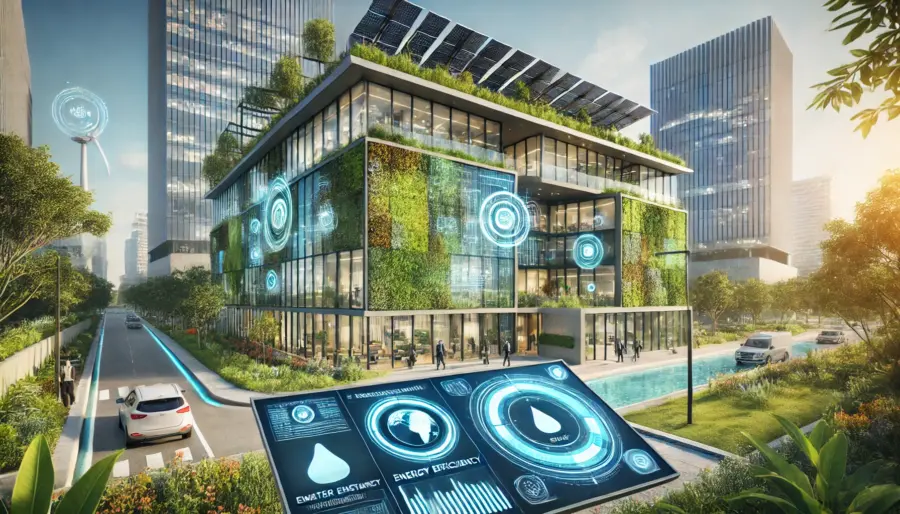Automation and Data Recording in Sustainable Architecture: Enhancing LEED Certification
Steps in your green building process
BY JOSEPH AZAR
March 2025
Introduction
As sustainable architecture continues to evolve, automation and data recording play a crucial role in improving energy efficiency, reducing environmental impacts, and meeting the rigorous standards of green building certifications like LEED (Leadership in Energy and Environmental Design). The integration of advanced technologies enables architects and project teams to design smarter, monitor real-time performance, and achieve better outcomes for both the environment and building occupants. This article explores how automation and data recording systems contribute to sustainable architecture and their direct relationship to LEED credits.

Understanding Automation in Sustainable Architecture
Automation in sustainable architecture refers to the use of intelligent systems and advanced technologies to manage building operations, optimize energy consumption, and ensure environmental sustainability. These automated systems can be embedded in building design from the conceptual stage to post-occupancy monitoring. They provide real-time control over heating, cooling, lighting, water usage, and other operational parameters.
Key Technologies Driving Automation
- Building Management Systems (BMS): Centralized systems that monitor and control mechanical and electrical systems like HVAC, lighting, and security.
- Smart Sensors and IoT: Internet of Things (IoT) devices collect and transmit data on temperature, humidity, occupancy, and energy use.
- Automated Lighting and Climate Control: Adaptive systems that adjust lighting and HVAC settings based on occupancy patterns and external environmental conditions.
- Energy Management Systems (EMS): Platforms that track energy consumption and optimize energy use through advanced algorithms and analytics.
The Role of Data Recording in Sustainable Architecture
Data recording involves capturing, storing, and analyzing performance data to ensure buildings meet sustainability targets. This information is crucial for optimizing building performance, ensuring compliance with environmental standards, and facilitating continuous improvement.
Benefits of Data Recording in Sustainable Design
- Performance Monitoring: Real-time data collection allows for ongoing performance assessment and quick identification of inefficiencies.
- Predictive Maintenance: Data analytics can predict system failures, reducing downtime and increasing operational efficiency.
- Occupant Comfort: Monitoring indoor environmental quality (IEQ) parameters ensures optimal thermal comfort, air quality, and lighting conditions.
- Compliance and Reporting: Accurate data supports compliance with sustainability standards and provides the documentation required for LEED certification.
How Automation and Data Recording Align with LEED Credits
LEED certification, developed by the U.S. Green Building Council (USGBC), is a globally recognized rating system that evaluates the environmental performance of buildings. Automation and data recording systems play a pivotal role in achieving and documenting compliance with LEED criteria.
LEED Credit Categories Benefiting from Automation and Data Recording
- Energy and Atmosphere (EA)
- EA Credit: Optimize Energy Performance: Automation helps reduce energy consumption through intelligent controls and continuous monitoring, while data recording provides the evidence required to document these savings.
- EA Credit: Building-Level Energy Metering: Automated meters track energy use across different building systems, supporting accurate reporting and optimization.
- EA Credit: Enhanced Commissioning: Automation aids in monitoring and verifying system performance, while data records ensure continuous commissioning during the building lifecycle.
- Indoor Environmental Quality (IEQ)
- IEQ Credit: Thermal Comfort: Automated HVAC systems maintain optimal temperature and humidity levels, while data records demonstrate compliance with ASHRAE standards.
- IEQ Credit: Indoor Air Quality Assessment: Sensors continuously monitor air quality, providing data to verify the building meets indoor pollutant limits.
- Water Efficiency (WE)
- WE Credit: Indoor Water Use Reduction: Automated water systems track consumption and implement efficient fixtures, with data supporting compliance reports.
- WE Credit: Building-Level Water Metering: Automated water metering systems monitor consumption patterns, ensuring accurate reporting and facilitating water-saving strategies.
- Innovation (IN)
- IN Credit: Innovation: Advanced automation and real-time data analytics can contribute to innovation credits by demonstrating cutting-edge strategies that go beyond the baseline LEED requirements.
Case Studies: Automation and LEED Success
Case Study 1: Intelligent Building Automation in a LEED Platinum Office
A corporate office achieved LEED Platinum certification by integrating a comprehensive Building Management System (BMS) that monitored lighting, HVAC, and energy consumption. Real-time data analytics allowed the project team to optimize building performance, achieving a 45% reduction in energy use compared to conventional buildings. Automated reporting streamlined the documentation required for LEED submission, ensuring compliance with EA and IEQ credits.
Case Study 2: Smart Water Management in a LEED Gold Hospital
A newly constructed hospital earned LEED Gold certification by implementing an automated water management system. Smart sensors monitored water usage in real-time, enabling quick leak detection and optimization of water-intensive systems. Data records supported WE credit documentation and demonstrated a 35% reduction in potable water use.
Future Trends in Automation and Data Recording for LEED
The future of sustainable architecture will continue to be shaped by advancements in automation and data recording technologies. Emerging trends include:
- Artificial Intelligence (AI) and Machine Learning: AI-driven models will predict energy consumption patterns and optimize building performance in real time.
- Digital Twins: Virtual models of buildings will allow for real-time simulations and advanced performance monitoring.
- Blockchain for Data Integrity: Blockchain technology will provide tamper-proof records for LEED documentation, ensuring transparency and accuracy.
- Enhanced Occupant Feedback Systems: Automated platforms will integrate real-time occupant feedback to further enhance indoor environmental quality.
Conclusion
Automation and data recording are transforming sustainable architecture by enabling smarter design decisions, optimizing building performance, and facilitating compliance with LEED certification requirements. As technologies continue to advance, their integration into sustainable design processes will become increasingly critical for achieving higher levels of environmental responsibility and operational efficiency. By embracing these innovations, architects and project teams can lead the way in shaping a sustainable future.

Artist/Architect/ LEED AP (BD+C)
Computational/ Environmental design
Enjoyed this article? Discover more in the Blog section

